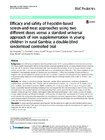Efficacy and safety of hepcidin-based screen-and-treat approaches using two different doses versus a standard universal approach of iron supplementation in young children in rural Gambia: a double-blind randomised controlled trial
dc.contributor.author
Wegmüller, Rita
dc.contributor.author
Bah, Amat
dc.contributor.author
Kendall, Lindsay
dc.contributor.author
Goheen, Morgan M.
dc.contributor.author
Mulwa, Sarah
dc.contributor.author
Cerami, Carla
dc.contributor.author
Moretti, Diego
dc.contributor.author
Prentice, Andrew M.
dc.date.accessioned
2019-06-28T14:22:46Z
dc.date.available
2017-06-12T12:52:26Z
dc.date.available
2019-06-28T14:22:46Z
dc.date.issued
2016
dc.identifier.issn
1471-2431
dc.identifier.other
10.1186/s12887-016-0689-4
en_US
dc.identifier.uri
http://hdl.handle.net/20.500.11850/120736
dc.identifier.doi
10.3929/ethz-b-000120736
dc.description.abstract
Background
Iron deficiency prevalence rates frequently exceed 50 % in young children in low-income countries. The World Health Organization (WHO) recommended universal supplementation of young children where anaemia rates are >40 %. However, large randomized trials have revealed that provision of iron to young children caused serious adverse effects because iron powerfully promotes microbial growth. Hepcidin – the master regulator of iron metabolism that integrates signals of infection and iron deficiency – offers the possibility of new solutions to diagnose and combat global iron deficiency. We aim to evaluate a hepcidin-screening-based iron supplementation intervention using hepcidin cut-offs designed to indicate that an individual requires iron, is safe to receive it and will absorb it.
Methods
The study is a proof-of-concept, three-arm, double blind, randomised controlled, prospective, parallel-group non-inferiority trial. Children will be randomised to receive, for a duration of 12 weeks, one of three multiple micronutrient powders (MNP) containing: A) 12 mg iron daily; B) 12 mg or 0 mg iron daily based on a weekly hepcidin screening indicating if iron can be given for the next seven days or not; C) 6 mg or 0 mg iron daily based on a weekly hepcidin screening indicating if iron can be given for the next seven days or not. The inclusion criteria are age 6-23 months, haemoglobin (Hb) concentration between 7 and 11 g/dL, z-scores for Height-for-Age, Weight-for-Age and Weight-for-Height > -3 SD and free of malaria. Hb concentration at 12 weeks will be used to test whether the screen-and-treat approaches are non-inferior to universal supplementation. Safety will be assessed using caregiver reports of infections, in vitro bacterial and P. falciparum growth assays and by determining the changes in the gut microbiota during the study period.
Discussion
A screen-and-treat approach using hepcidin has the potential to make iron administration safer in areas with widespread infections. If this proof-of-concept study shows promising results the development of a point-of-care diagnostic test will be the next step.
en_US
dc.format
application/pdf
en_US
dc.language.iso
en
en_US
dc.publisher
BioMed Central
en_US
dc.rights.uri
http://creativecommons.org/licenses/by/4.0/
dc.subject
Anaemia
en_US
dc.subject
Children
en_US
dc.subject
Gambia
en_US
dc.subject
Hepcidin
en_US
dc.subject
Iron deficiency
en_US
dc.subject
Iron deficiency anaemia
en_US
dc.subject
Iron supplementation
en_US
dc.subject
Safety
en_US
dc.subject
Sub-Saharan Africa
en_US
dc.title
Efficacy and safety of hepcidin-based screen-and-treat approaches using two different doses versus a standard universal approach of iron supplementation in young children in rural Gambia: a double-blind randomised controlled trial
en_US
dc.type
Journal Article
dc.rights.license
Creative Commons Attribution 4.0 International
dc.date.published
2016-09-01
ethz.journal.title
BMC Pediatrics
ethz.journal.volume
16
en_US
ethz.journal.abbreviated
BMC Pediatr
ethz.pages.start
149
en_US
ethz.size
9 p.
en_US
ethz.version.deposit
publishedVersion
en_US
ethz.identifier.wos
ethz.identifier.scopus
ethz.publication.place
London
en_US
ethz.publication.status
published
en_US
ethz.leitzahl
ETH Zürich::00002 - ETH Zürich::00012 - Lehre und Forschung::00007 - Departemente::02070 - Dep. Gesundheitswiss. und Technologie / Dep. of Health Sciences and Technology::02701 - Inst.f. Lebensmittelwiss.,Ernährung,Ges. / Institute of Food, Nutrition, and Health::03957 - Zimmermann, Michael Bruce (emeritus) / Zimmermann, Michael Bruce (emeritus)
en_US
ethz.leitzahl.certified
ETH Zürich::00002 - ETH Zürich::00012 - Lehre und Forschung::00007 - Departemente::02070 - Dep. Gesundheitswiss. und Technologie / Dep. of Health Sciences and Technology::02701 - Inst.f. Lebensmittelwiss.,Ernährung,Ges. / Institute of Food, Nutrition, and Health::03957 - Zimmermann, Michael Bruce (emeritus) / Zimmermann, Michael Bruce (emeritus)
ethz.date.deposited
2017-06-12T12:55:11Z
ethz.source
ECIT
ethz.identifier.importid
imp593654b9710c569222
ethz.ecitpid
pub:182812
ethz.eth
yes
en_US
ethz.availability
Open access
en_US
ethz.rosetta.installDate
2017-07-19T08:55:38Z
ethz.rosetta.lastUpdated
2024-02-02T08:24:46Z
ethz.rosetta.versionExported
true
ethz.COinS
ctx_ver=Z39.88-2004&rft_val_fmt=info:ofi/fmt:kev:mtx:journal&rft.atitle=Efficacy%20and%20safety%20of%20hepcidin-based%20screen-and-treat%20approaches%20using%20two%20different%20doses%20versus%20a%20standard%20universal%20approach%20of%20iro&rft.jtitle=BMC%20Pediatrics&rft.date=2016&rft.volume=16&rft.spage=149&rft.issn=1471-2431&rft.au=Wegm%C3%BCller,%20Rita&Bah,%20Amat&Kendall,%20Lindsay&Goheen,%20Morgan%20M.&Mulwa,%20Sarah&rft.genre=article&rft_id=info:doi/10.1186/s12887-016-0689-4&
Files in this item
Publication type
-
Journal Article [128982]

